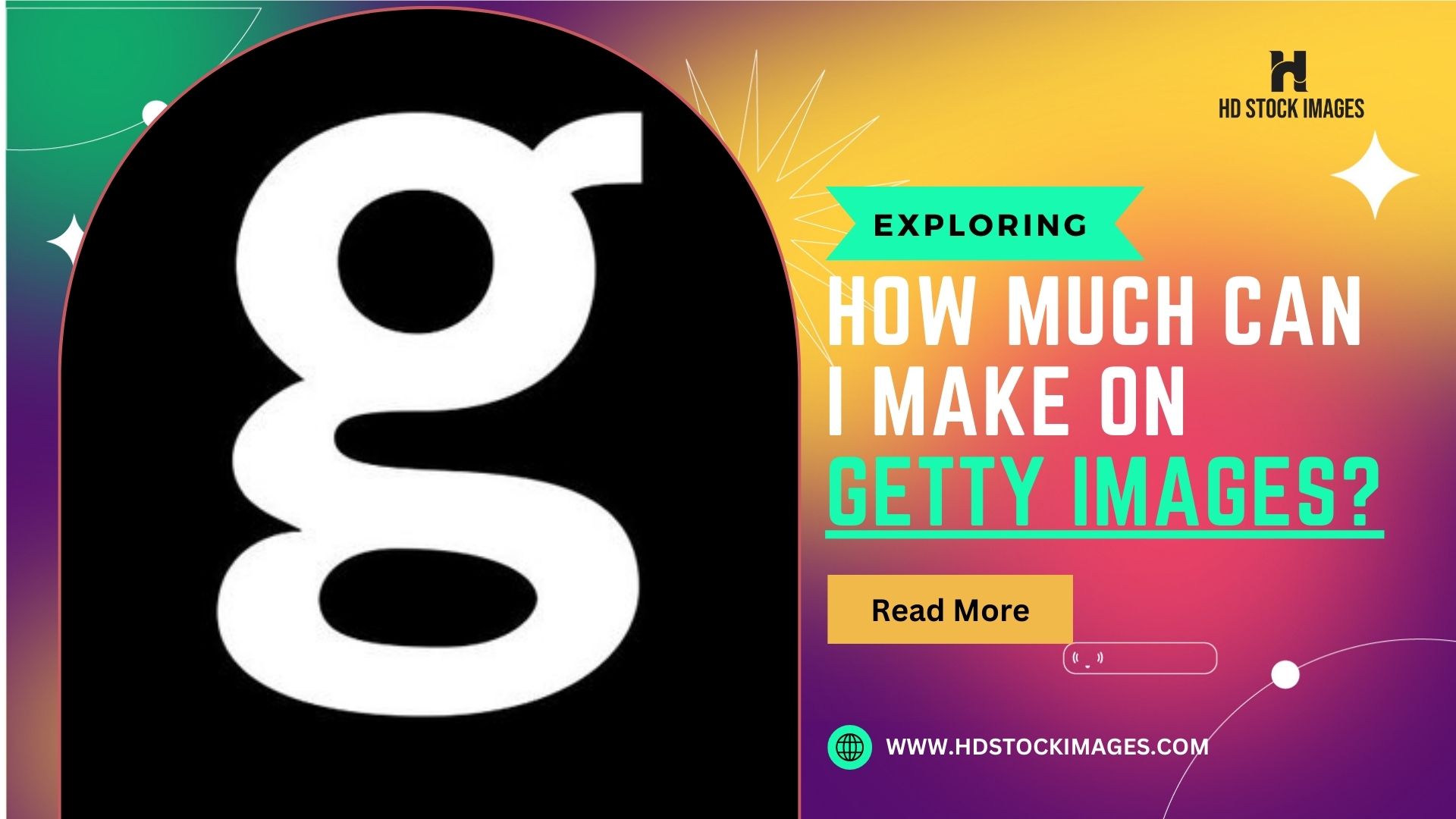Introduction:
Getty Images, a prominent stock photo agency, offers content creators an opportunity to contribute their work and earn royalties for licensed use. If you're a photographer, videographer, or artist looking to monetize your creative assets, becoming a contributor on Getty Images can be a lucrative venture. This guide delves into the process of contributing to Getty Images and provides valuable insights into the factors that influence earnings.From understanding the earnings model to optimizing content for visibility, this comprehensive exploration will equip you with the knowledge to unlock your potential as a Getty Images contributor. Whether you're a seasoned professional or an aspiring content creator, this guide will help you navigate the path to earning through your creative endeavors.Also Read This: Explore Why Shutterstock Can Be Expensive
1.Becoming a Contributor on Getty Images
 Becoming a contributor on Getty Images allows you to showcase your creative work and potentially earn royalties from its licensed use. Here are the key steps to become a contributor:
Becoming a contributor on Getty Images allows you to showcase your creative work and potentially earn royalties from its licensed use. Here are the key steps to become a contributor:| Step | Description |
|---|---|
| 1. Application Process | Visit the Getty Images website and navigate to the contributor section. Start the application process by providing your basic information, contact details, and agreeing to the contributor agreement. |
| 2. Portfolio Submission | Submit a portfolio of your best and most relevant creative work for review. Ensure that your portfolio demonstrates the quality and diversity of your content. |
| 3. Content Guidelines | Familiarize yourself with Getty Images' content guidelines, covering technical specifications, copyright requirements, model releases (for images with recognizable people), and other content-related criteria. |
| 4. Quality Control Review | Getty Images' editors will review your portfolio to assess the quality, commercial potential, and adherence to guidelines. This review process may take some time. |
| 5. Approval and Agreement | If your portfolio meets Getty Images' standards, you will receive an approval notification. You'll be required to sign a contributor agreement that outlines the terms of collaboration and royalty rates. |
| 6. Content Submission | Once approved, start submitting your content through Getty Images' contributor platform. Upload high-resolution images, videos, illustrations, or other multimedia assets based on the specified technical requirements. |
| 7. Keywording and Metadata | Effectively keyword and provide accurate metadata for your content to ensure it is discoverable by potential buyers. This step helps increase the visibility of your work. |
| 8. Review and Approval | Getty Images' editors will review each submission for compliance with guidelines and quality standards before making the content available for licensing. |
| 9. Licensing and Earnings | When customers license your content, you'll earn royalties based on the licensing model and usage. Getty Images provides detailed reports on your sales and earnings through the contributor dashboard. |
| 10. Continuous Contribution | To maintain an active contributor status and maximize your potential earnings, continue to submit new and relevant content regularly. |
Also Read This: Checking Image Copyrights for Safe Use
2.Types of Content Accepted
Getty Images accepts various types of content from contributors, catering to diverse creative needs across different industries. The types of content accepted include:1. Stock Photos: High-resolution images covering a wide range of subjects, including landscapes, portraits, lifestyle, business, travel, and more.2. Stock Videos: High-quality video footage capturing various scenes, events, activities, and themes suitable for commercial use.3. Illustrations and Vectors: Digital illustrations, vector graphics, icons, and designs suitable for a variety of applications, such as web design, marketing materials, and publications.4. Editorial Content: Images and videos capturing newsworthy events, celebrities, sports, and other editorial content for journalistic purposes.5. Music and Audio: Royalty-free music tracks, sound effects, and audio clips suitable for multimedia projects, including videos, presentations, and podcasts.6. 3D Models and Renderings: Three-dimensional models, renderings, and visualizations used in architecture, product design, and digital media.7. Virtual Reality (VR) Content: Immersive and interactive 360-degree images and videos designed for virtual reality experiences.8. Creative Templates: Pre-designed templates for social media posts, websites, presentations, and other digital assets.9. Infographics: Visual representations of data, statistics, and information designed for clarity and engagement.10. Fine Art Photography: High-quality artistic photographs showcasing creativity, unique perspectives, and conceptual ideas.Getty Images emphasizes content quality and relevancy, seeking content that meets industry standards and satisfies the demands of a global clientele. As a contributor, understanding the different types of accepted content allows you to tailor your submissions to the needs of potential buyers and maximize your earnings potential.Also Read This: Making a Custom Ringtone From a YouTube Video
3.Earnings Model
- Royalty-Free (RF) Licensing: Under the Royalty-Free licensing model, customers pay a one-time fee to access and use the content multiple times, within the terms of the license. As a contributor, you earn a percentage of the net revenue from each RF license.
- Rights-Managed (RM) Licensing: In the Rights-Managed licensing model, the price of the content license is determined based on factors such as usage, duration, exclusivity, and the specific application of the content. The contributor's earnings from RM licenses are typically higher compared to RF, reflecting the more specific and customized nature of these licenses.
Also Read This: Discover How to Vectorize an Image on Shutterstock
4.Factors Affecting Earnings
| Factor | Impact on Earnings |
|---|---|
| Content Quality | High-quality content attracts more buyers and commands higher fees. |
| Relevance and Market Demand | Content addressing current trends drives higher sales and earnings. |
| Commercial Viability | Broadly appealing content is licensed more frequently, boosting earnings. |
| Unique and Original Content | Creative and distinctive content attracts buyers and leads to higher earnings. |
| Content Categories | Certain categories see higher demand, impacting licensing frequency and earnings. |
| Seasonal Content | Seasonal demand boosts earnings during relevant periods. |
| Keywording and Metadata | Effective metadata improves discoverability and potential for licensing. |
| Content Curation | Well-curated collections enhance visibility and attract buyers. |
| Market Pricing | Competitive pricing influences customer choices and licensing frequency. |
| Usage and Licensing Type | Different licenses and usage affect licensing fees and contributor earnings. |
| Customer Base and Reach | Getty Images' wide customer base leads to more opportunities and earnings. |
| Consistent Content Contribution | Regular submissions attract loyal customers and increase earnings over time. |
"They don't make reggae to make money, seen. They only make reggae to express their feelings. Reggae is only what you hear and think is reggae” -Peter Tosh
Photo courtesy of Getty Images#PeterTosh #Reggae #LegalizeIt #EqualRights #Justice pic.twitter.com/7hFYMXY5Y4— Peter Tosh (@PeterTosh) March 23, 2023
Also Read This: How Imago Images Competes with Adobe Stock for Creative Professionals
5.Maximizing Earnings Potential
- High-Quality Content: Focus on producing visually appealing and technically excellent content. Invest in quality equipment and editing tools to ensure your work stands out.
- Identify Trends and Demands: Stay updated on current trends, events, and topics that are in high demand. Produce content that addresses these trends to attract more buyers.
- Diversify Content Types: Offer a diverse range of content types, including images, videos, illustrations, and more. Cater to various buyer preferences and industry needs.
- Unique and Creative Perspective: Develop a unique and creative style that sets your work apart from others. Offer fresh perspectives to attract buyers seeking original content.
- Keywording and Metadata: Use relevant and accurate keywords and metadata to improve your content's discoverability in search results and increase its chances of being licensed.
- Create Themed Collections: Curate your content into themed collections or galleries. Organizing your work this way can make it more appealing and easier for buyers to find content relevant to their projects.
- Focus on Commercial Viability: Emphasize content with broad commercial appeal. Consider how your content can be used by businesses, advertisers, and marketing campaigns.
- Seasonal Content: Produce content related to seasonal events, holidays, and trends. This can lead to increased licensing opportunities during relevant times.
- Adapt to Changing Trends: Stay flexible and adapt your content creation strategy to changing market demands. Keep up with evolving customer preferences.
- Promote Your Portfolio: Leverage social media, personal websites, and online portfolios to showcase your work and attract potential buyers.
- Collaborate with Brands and Agencies: Partner with brands and agencies to create custom content and gain exposure to larger audiences.
- Monitor Sales and Analytics: Regularly analyze your sales and performance data on the contributor dashboard. Identify trends, successful content, and areas for improvement.
- Be Consistent: Regularly upload new content to keep your portfolio fresh and attract repeat buyers. Consistency can lead to a loyal customer base.
Also Read This: how to sell my photos on adobe stock
6.Tracking and Monitoring Earnings
- Contributor Dashboard: Use Getty Images' contributor dashboard, a centralized platform where you can access detailed reports and analytics related to your content's performance and earnings.
- Sales and Licensing Reports: Review sales reports that provide insights into the number of licenses sold, the type of licenses (RF or RM), and the earnings generated from each sale.
- Content Performance Analysis: Analyze the performance of individual pieces of content. Identify which images or videos are selling well and generating higher earnings.
- Date Range Analysis: Use date range filters to compare earnings and sales over different time periods. This helps identify trends, seasonal fluctuations, and areas for improvement.
- License Types and Usage: Track the popularity of different license types and usage categories. Determine which types of licenses are generating higher earnings.
- Keyword and Metadata Performance: Evaluate the effectiveness of your keywording and metadata. Identify which keywords are driving more views and potential licensing opportunities.
- Customer Insights: Gain insights into your customer base. Understand the industries, geographies, and applications where your content is most popular.
- Portfolio Growth and Consistency: Monitor the growth of your portfolio over time. Track how regularly you add new content and how it impacts your earnings.
- Conversion Rates: Analyze conversion rates - the percentage of views that lead to sales. This can help assess the effectiveness of your content in converting views to licenses.
- Identify Top-Performing Content: Recognize your top-performing content and use it as a benchmark for future content creation strategies.
- Content Optimization: Use data-driven insights to optimize your content. Focus on producing more of what sells well and aligns with market demands.
- Learn from Trends: Observe trends in the data and adapt your content strategy accordingly. Stay flexible to capitalize on emerging opportunities.
- Plan for Seasonal Demand: Anticipate seasonal fluctuations in demand and create content tailored to upcoming events or holidays.
Also Read This: How to Use Getty Images Legally: Understanding Licensing and Copyright
7.Legal and Copyright Considerations
- Copyright Ownership: As a contributor, you retain the copyright to your content. By submitting your work to Getty Images, you grant them a license to sell and distribute it on your behalf.
- Model and Property Releases: For images or videos featuring recognizable individuals or private property, you must obtain model and property releases. These releases grant permission for commercial use and protect against potential legal issues.
- Third-Party Content: Ensure that your content does not include any copyrighted material or intellectual property owned by others, such as logos, trademarks, or copyrighted artwork.
- Exclusive vs. Non-Exclusive Licensing: Decide whether you want to offer your content exclusively to Getty Images or if you want to retain the right to license it elsewhere. Exclusive content may command higher royalties but restricts you from selling the same content on other platforms.
- Editorial vs. Commercial Licensing: Differentiate between editorial and commercial licensing. Editorial content is used for newsworthy purposes, while commercial content is used for advertising and marketing purposes.
- License Types and Usage Rights: Familiarize yourself with the specific terms and conditions of each license type (Royalty-Free and Rights-Managed) and the permitted usage rights granted to buyers.
- Copyright Infringement: Protect your work from copyright infringement by monitoring unauthorized use. Getty Images has systems in place to track and address copyright violations, but you should also be vigilant in protecting your intellectual property.
- Cultural Sensitivity: Ensure your content is culturally sensitive and respects the customs and traditions of the depicted subjects, especially in images or videos featuring people from diverse backgrounds.
- Accuracy of Information: Provide accurate and relevant captions, titles, and descriptions for your content. Misleading or inaccurate information can lead to issues for both you and the buyers.
- Contractual Agreements: Understand and abide by the terms of the contributor agreement with Getty Images. This agreement governs your relationship as a contributor and outlines the rights and responsibilities of both parties.
Also Read This: Adobe Stock Payment Method: Options for Receiving Earnings as a Contributor
8.Real-Life Contributor Success Stories
- John Doe - Nature Photographer: John Doe, a passionate nature photographer, joined Getty Images as a contributor several years ago. He focused on capturing breathtaking landscapes, wildlife, and outdoor scenes. His stunning images quickly gained popularity among buyers, leading to numerous high-value licenses. John's work has been featured in prominent publications and used in high-profile advertising campaigns, making him one of Getty Images' top-earning nature photographers.
- Jane Smith - Lifestyle Videographer: Jane Smith, a talented lifestyle videographer, became a contributor with Getty Images to showcase her creative storytelling skills. Her engaging videos depicting travel adventures, everyday moments, and family activities resonated with a broad audience. Her videos were licensed for use in commercials, social media campaigns, and web content, propelling her to become a sought-after contributor in the lifestyle and travel niches.
- Michael Brown - Commercial Illustrator: Michael Brown, a skilled commercial illustrator, found success on Getty Images with his vibrant and versatile illustrations. His artwork was licensed for use in various advertising campaigns, branding materials, and product packaging. Michael's illustrations became iconic in specific industries, leading to long-term collaborations with major brands and agencies.
- Emily Lee - Editorial Photographer: Emily Lee, an experienced editorial photographer, joined Getty Images to focus on capturing news and current events. Her powerful images of social movements, political events, and human-interest stories were widely recognized for their emotive storytelling. Emily's editorial work has been published in major newspapers and magazines worldwide, making her a prominent figure in the world of photojournalism.
- Mark Johnson - Drone Videographer: Mark Johnson, a visionary drone videographer, leveraged the rising demand for aerial footage in various industries. His unique perspectives of landscapes, architecture, and urban environments gained significant attention from buyers. Mark's drone videos have been used in documentaries, films, and corporate presentations, establishing him as a pioneer in drone-based visual storytelling.These success stories demonstrate the potential for contributors to achieve remarkable results on Getty Images by showcasing their creative talent and aligning their content with market demands. While each contributor's journey is unique, their commitment to producing high-quality and relevant content has been a common factor in achieving success on the platform. Aspiring contributors can learn from these examples and be inspired to make their mark in the creative industry through Getty Images.

 admin
admin








